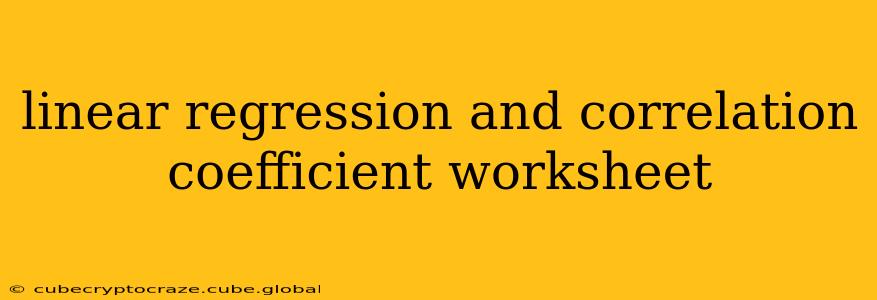Linear Regression and Correlation Coefficient: A Comprehensive Worksheet
This worksheet explores the concepts of linear regression and the correlation coefficient, crucial tools in statistical analysis for understanding the relationship between variables. We'll delve into calculating and interpreting these measures, clarifying their strengths and limitations.
What is Linear Regression?
Linear regression is a statistical method used to model the relationship between a dependent variable (the outcome we're interested in) and one or more independent variables (predictors). It aims to find the best-fitting straight line through a scatter plot of data points. This line, represented by the equation y = mx + c (where 'm' is the slope and 'c' is the y-intercept), allows us to predict the value of the dependent variable based on the independent variable.
What is the Correlation Coefficient?
The correlation coefficient (often denoted as 'r') measures the strength and direction of the linear relationship between two variables. It ranges from -1 to +1:
- +1: Perfect positive correlation – as one variable increases, the other increases proportionally.
- 0: No linear correlation – there's no linear relationship between the variables.
- -1: Perfect negative correlation – as one variable increases, the other decreases proportionally.
Values between -1 and +1 indicate varying degrees of correlation, with values closer to -1 or +1 representing stronger correlations.
Calculating Linear Regression and the Correlation Coefficient
While complex calculations are often done using statistical software, understanding the underlying principles is essential. The formulas below illustrate the core concepts:
-
Slope (m):
m = Σ[(xi - x̄)(yi - ȳ)] / Σ[(xi - x̄)²]where xi and yi are individual data points, and x̄ and ȳ are the means of the x and y variables, respectively. -
Y-intercept (c):
c = ȳ - m * x̄ -
Correlation Coefficient (r):
r = Σ[(xi - x̄)(yi - ȳ)] / √[Σ(xi - x̄)² * Σ(yi - ȳ)²]
Let's Practice!
Below are some example datasets. We'll work through calculating the linear regression equation and the correlation coefficient for each. Remember, you can use statistical software or calculators to verify your answers.
Dataset 1:
| Hours Studied (x) | Exam Score (y) |
|---|---|
| 2 | 60 |
| 4 | 70 |
| 6 | 80 |
| 8 | 90 |
| 10 | 100 |
Dataset 2:
| Advertising Spend (x) | Sales (y) |
|---|---|
| 1000 | 1500 |
| 2000 | 2000 |
| 3000 | 2200 |
| 4000 | 3000 |
| 5000 | 3500 |
Questions:
1. What are the assumptions of linear regression?
Linear regression relies on several key assumptions. The relationship between the independent and dependent variables should be linear. The data should be independent (one data point doesn't influence another). The residuals (the differences between observed and predicted values) should be normally distributed and have constant variance (homoscedasticity). There should be no significant outliers influencing the results. Violation of these assumptions can lead to inaccurate or misleading results.
2. How do you interpret the R-squared value in linear regression?
The R-squared value represents the proportion of variance in the dependent variable explained by the independent variable(s). A higher R-squared (closer to 1) indicates a better fit of the model, meaning the independent variable(s) effectively explain a larger portion of the variation in the dependent variable. However, a high R-squared doesn't automatically imply a good model – it's crucial to assess the model’s assumptions and context.
3. Can you have a strong correlation but no causation?
Yes, absolutely. Correlation only indicates a relationship between two variables; it doesn't imply that one variable causes changes in the other. A strong correlation could be due to a third, unobserved variable (a confounding variable) influencing both, or it could simply be a coincidence. For example, ice cream sales and drowning incidents might show a positive correlation, but one doesn't cause the other – both are likely related to warmer weather.
4. What are the limitations of linear regression?
Linear regression assumes a linear relationship, which may not always be the case. It's sensitive to outliers, which can disproportionately influence the results. It might not capture complex relationships between variables that aren't linear. Interpreting the results requires careful consideration of the context and assumptions.
5. How do you choose the best fitting line for a dataset using linear regression?
The best fitting line in linear regression is determined by minimizing the sum of the squared residuals. The method of least squares is commonly used to find the line that minimizes this sum, leading to the most accurate estimations of the slope and y-intercept. This technique aims to find the line that best represents the overall trend in the data.
By completing the calculations for the datasets and answering these questions, you'll gain a solid understanding of linear regression and the correlation coefficient. Remember to consult statistical resources and software for more complex analyses.
